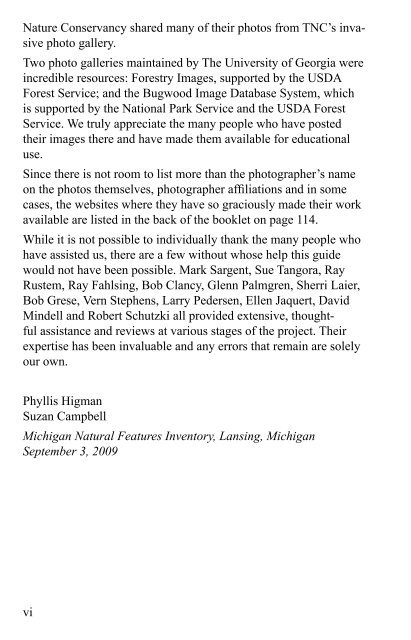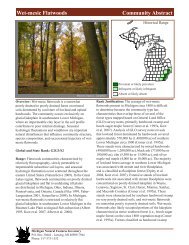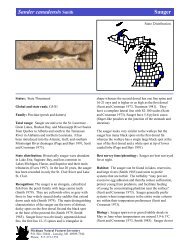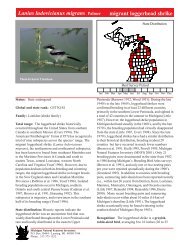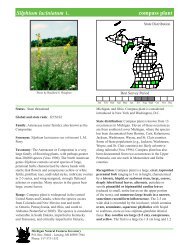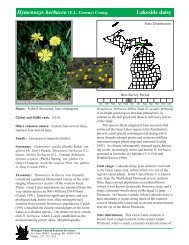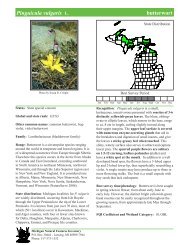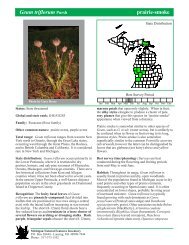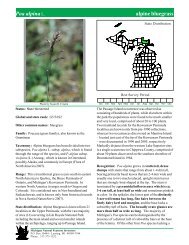Invasive Plants - Michigan Natural Features Inventory - Michigan ...
Invasive Plants - Michigan Natural Features Inventory - Michigan ...
Invasive Plants - Michigan Natural Features Inventory - Michigan ...
You also want an ePaper? Increase the reach of your titles
YUMPU automatically turns print PDFs into web optimized ePapers that Google loves.
Nature Conservancy shared many of their photos from TNC’s invasive<br />
photo gallery.<br />
Two photo galleries maintained by The University of Georgia were<br />
incredible resources: Forestry Images, supported by the USDA<br />
Forest Service; and the Bugwood Image Database System, which<br />
is supported by the National Park Service and the USDA Forest<br />
Service. We truly appreciate the many people who have posted<br />
their images there and have made them available for educational<br />
use.<br />
Since there is not room to list more than the photographer’s name<br />
on the photos themselves, photographer affiliations and in some<br />
cases, the websites where they have so graciously made their work<br />
available are listed in the back of the booklet on page 114.<br />
While it is not possible to individually thank the many people who<br />
have assisted us, there are a few without whose help this guide<br />
would not have been possible. Mark Sargent, Sue Tangora, Ray<br />
Rustem, Ray Fahlsing, Bob Clancy, Glenn Palmgren, Sherri Laier,<br />
Bob Grese, Vern Stephens, Larry Pedersen, Ellen Jaquert, David<br />
Mindell and Robert Schutzki all provided extensive, thoughtful<br />
assistance and reviews at various stages of the project. Their<br />
expertise has been invaluable and any errors that remain are solely<br />
our own.<br />
Phyllis Higman<br />
Suzan Campbell<br />
<strong>Michigan</strong> <strong>Natural</strong> <strong>Features</strong> <strong>Inventory</strong>, Lansing, <strong>Michigan</strong><br />
September 3, 2009<br />
What is an invasive plant?<br />
The National <strong>Invasive</strong> Species Management Plan, developed in<br />
response to Executive Order 13112, defines an invasive species as<br />
“a species that is non-native to the ecosystem under consideration<br />
and whose introduction causes or is likely to cause economic or<br />
environmental harm or harm to human health.” For the purposes of<br />
this field guide, non-native species are those that did not occur in<br />
<strong>Michigan</strong>’s ecological communities prior to widespread European<br />
settlement.<br />
Only a small fraction of the hundreds of non-native plants that<br />
have evolved elsewhere and been brought to <strong>Michigan</strong> are<br />
invasive. The few that are, however, can be very aggressive and<br />
spread rapidly once established. In our native forests, grasslands,<br />
wetlands and dunes, they pose a threat to management goals by<br />
displacing native species or altering ecosystem processes. It is<br />
these harmful non-native species that are the focus of this field<br />
guide.<br />
Impacts of non-native invasive plants<br />
<strong>Invasive</strong> species are a significant threat to <strong>Michigan</strong>’s native<br />
biodiversity and their impacts are wide-ranging. They are aggressive<br />
competitors, often dominating an ecosystem and reducing native<br />
diversity dramatically. They have effective reproductive and<br />
dispersal mechanisms; many are capable of spreading by rhizomes<br />
and some can produce new plants from tiny root or stem fragments.<br />
Many store energy in extensive root systems and can sprout back<br />
repeatedly after cutting. Most invasive plants produce abundant<br />
fruit and seeds that are widely dispersed and remain viable in the<br />
soil for years.<br />
Some invasive shrubs and trees create dense shade, preventing the<br />
growth of native herbs beneath them. They often leaf out early in<br />
spring and retain leaves late into the season, gaining as much as an<br />
extra month of productivity compared to some of their native associates.<br />
Some species secrete chemicals that inhibit the growth of<br />
neighboring plants or beneficial soil fungi. <strong>Invasive</strong> plants simplify<br />
ecosystem structure, and may alter site hydrology, nutrient cycles<br />
or patterns of natural disturbance, such as fire regimes.<br />
vi vii


